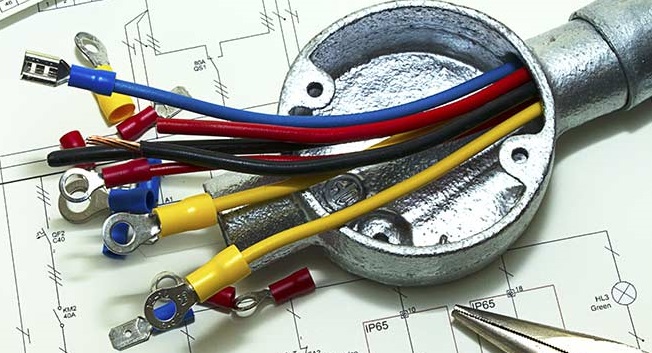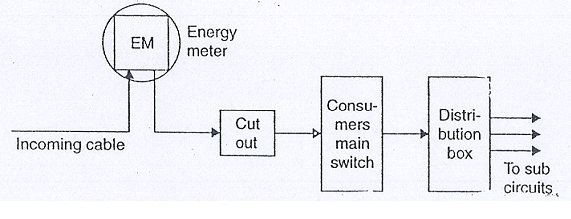Electrical wiring generally refers to insulated conductor used to carry current including the associated devices. Domestic electric appliances like lights, fans, washing machines, water pumps etc are connected to the supply through insulated wires which are controlled by switches. The wiring diagram gives the connections of different appliances to the supply within a house or building.
Electricity supplier provides electric supply up to a point outside the consumer premises. From this point consumer takes the connection to his main board . Insulated electrical wires will be taken out to various places in the premises to supply power to different type of loads like lights , fans , refrigerators , room coolers , heaters,etc.
Selection of Wiring Installation Material
The conductor material, insulation , size and the number of cores, specifies the electrical wires. The conductors are usually of either copper or aluminium. Various insulating materials like PVC,TRS, LSZH and VIR are used. The wire may be of single strand or multi strand. Wires with combination of different diameters and the number of cores or strands are available and should be arranged before wiring work.
The selection of the wire is made depending on the requirement considering factors like current and voltage ratings, cost and application. The current carrying capacity depends on the total area of the wires. Wires are drawn along the consumer’s building to distribute power to all points where load is situated.

There are different types of wiring according to the uses i.e. domestic, commercial and industrial wiring. Below procedure is mainly useful for both domestic and commercial purposes.
Method Of Electrical Wiring Installation for Lighting & Power
Before starting the electrical wiring for the lighting system and power points, make sure that the plaster work is finished completely in that area / floor & there is no more water or moisture on the walls. Additionally also make sure that there is no water or any rubbish inside the electrical conduits.
Generally at the false ceiling area (60 x 60), we have to use a ceiling rose with a heat resistance wire. On the other hand where there is gypsum board ceiling, we have to extend the wires from the slab to the expected level of the gypsum ceiling through a flexible conduits.
For the light & Power circuits, wires & cables will be used as per the approved material for the building or project. Which in most of the cases is 2.5 sq. mm for the lighting circuits & 4.0 sq. mm for the power circuits.
Please remember that lighting & Power circuits will be run in separate conduits. The wires & cables will be installed in conduits, trunking and ladders as per the approved shop drawings. For branch circuit work, originating from light & power panel boards will be arranged as per the approved drawings. Loads on various phases of panel boards will be balanced as per he approved load schedules.
For avoiding any damaged for the conductors, insulation or jacket of the wire or cable during the pulling stage, and lubricants will be used properly to prevent any stresses on conductors. For pulling the wires, we will first pull or insert 3 mm thick galvanized standard steel wire with wooden blocks fastened at ends in empty service conduits.
At every branch circuit outlet & pull-box, every cable passing through will be left slack to allow inspection & for connection to be made. Cables terminating in outlet boxes will be left with at least 250mm extra length for terminations. All circuits will be properly labeled during the pulling work to facilitate the terminations at the respective devices. – After the pulling circuit works completely, all the circuits will be checked & tested for open circuits, short circuits, earthing continuity & excessive resistance or leakage etc.

General rules of domestic wiring installation
- Cut-out to be provided on consumer’s premises.
- Meters, maximum demand indicators and other apparatus to be provided on consumer premises.
- Weatherproof wire for service connection with sufficient current carrying capacity to be provided.
- All conductor/wire should be sage in all term of voltage rating with proper insulation.
- Every line or phase should be protected by suitable ratings fuse.
- In metal conduit wiring metal conduit pipe should be continuously earthed.
- Each load point an appliances should be connected to independent control switch.
- In any building wiring installation, there must be separate sub circuits for light/fan/3 pin socket load and for 3 pin socket 15 Ampere power load.
- In any light/fan and the number of load points connected in one sub circuit should be less than 10(ten).
- In any power sub circuit, the maximum should not be more than 3000 watts and the number of power point should be up to two only.
- The rating of fuse in any circuit should not be less than half the capacity of the lowest size cable. In any sub-circuit the fuse rating should not be more than 5 amp.
- The earthed terminals of all 3 pin sockets outlets and plugs should be permanently connected to the earth wire.
- Sufficient number of 3 pin socket outlets should be provided at suitable places in all rooms of the building.
- In the bath rooms. the 3 pin socket should be at a height of not less than 1.5 m.
- All ceiling fans are to be hung 2.75 m above the floor level refer IS :4648 -1968.
- In the domestic wiring earth wire should be of 14 SWG GI for single phase supply and for 3 phase supply system earth wire must be of 8 SwG GI.
- If the load on any domestic wiring installation exceeds 6.0 kw. then 3 415 v. 50 Hz, 4 wire supply should be used. The load on 3 phases should be properly balanced.
- when the covered area in the building complex is more than 5000 m2 and the total load is more than 1000kva. The separate sub station is required to be installed.
Discover more from Electrical Engineering 123
Subscribe to get the latest posts sent to your email.

